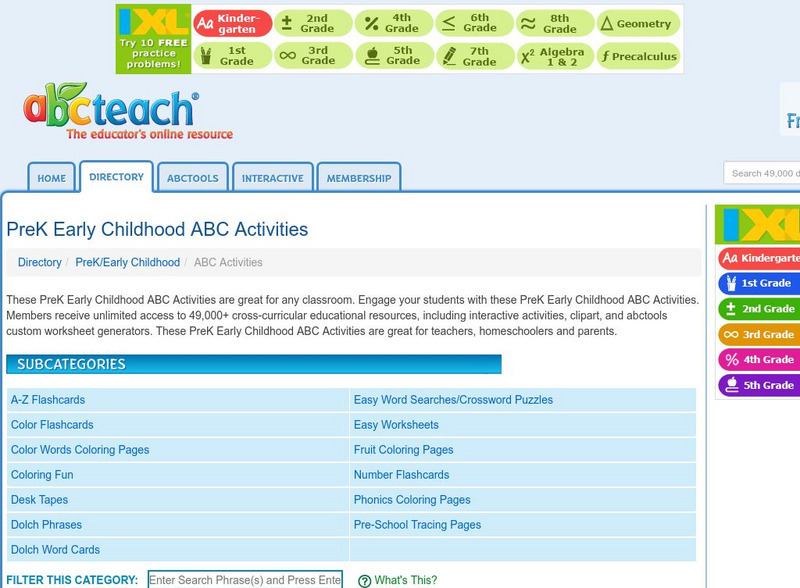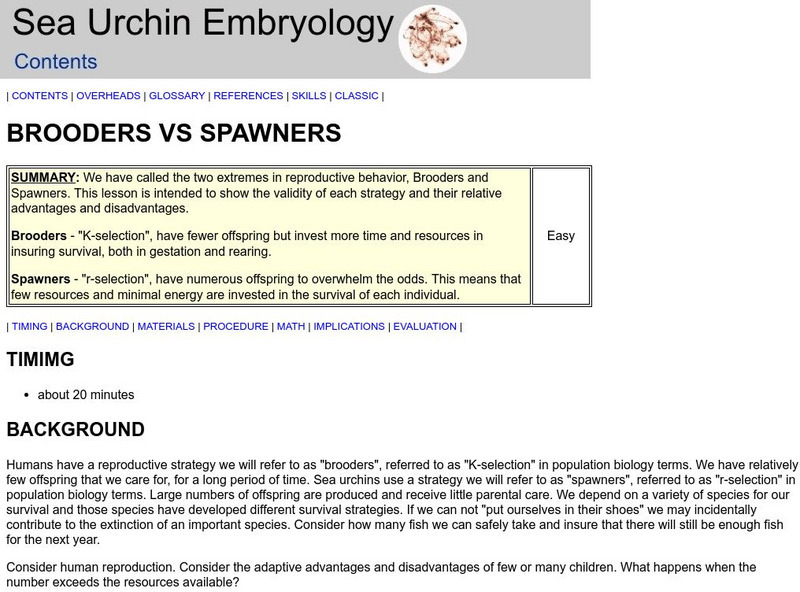Hi, what do you want to do?
Curated OER
Make Sense of Nature
Students participate in this program that heightens their awareness and curiosity of nature as well as their sense of adventure and exploring new surroundings. They identify and choose an object from nature after exploring it with other...
Curated OER
Classification of Animals
Third graders practice classiyfying items and identify three major characteristics scientists use to classify animals. They describe the differences between ectothermic and endothermic animals.
Curated OER
Make A Farm
Students use legos to create a farm. In this farm lesson plan, students create farm animals, a fence, a barn, trees, and more.
Curated OER
Local Environmental Issues: Pollution
Third graders discuss the ways in which human interaction with the environment and production of waste products contribute to pollution. Through a pollution demonstration, they explain how various groups of plants and animals can be...
Curated OER
Water Quality Monitoring
Students comprehend the four parameters of water quality. They perform tests for salinity, dissolved oxygen, pH and clarity or turbidity. Students comprehend why scientists and environmental managers monitor water uality and aquatic...
Curated OER
PBS Kids Go Buster Buffalo Round-Up
Second graders visit Rapid City, South Dakota, and Jackson Hole, Wyoming in these two episodes of Buster. They examine the Lakota people in South Dakota to see what it means to persevere. They sing songs and study idioms. They brainstorm...
Curated OER
Introduction to the Dictionary
First graders explore how to use a dictionary. They discuss how the dictionary is organized and how to locate words in the dictionary and students use the dictionary to locate words.
Curated OER
Make It All Better!
Students design an innovation that could help their community. In this technology lesson, students identify problems that could be solved by innovation. They present their ideas in class.
Curated OER
Theodore Roosevelt: Rough Rider to Rushmore
Eleventh graders study and answer questions about Theodore Roosevelt.
Curated OER
Roll-A-Story
Students combine the use of geographical information and writing. They write a story and create a visual aid to be used when presenting to the class. They move to different stations deciding which topic they want to further research. ...
Curated OER
Starting Off
Students practice starting and stopping safely at a signal given by the teacher as they practice different locomotor movements.
Curated OER
The Chain Gang
Students perform a food chain simulation to determine what happens when a food chain is broken.
Curated OER
Mapping Fairfax County Service Providers
Middle schoolers brainstorm a list of services governments should have available to its citizens. Using the internet, they locate as many of these services as possible and compile a class list. They also analyze specific programs to...
Curated OER
It's Okay to Exhale: Photosynthesis and Cellular Respiration
Pupils will observe the differences between photosynthesis and cellular respiration. Then they observe the links due to climate changes and relate how climate change affects their lives.
Curated OER
Spot the Differences
In this spot the difference worksheet, students analyze pictures of two different wallabies to see if they can find six differences between the two.
Curated OER
Learning Bird Traits
Students draw and label a bird. In this bird traits lesson, students learn what traits make a bird different from other animals. Students are taught how to draw a bird and are expected to label the various body parts they drew.
Khan Academy
Khan Academy: Hands on Activity: String Art
This is a hands on activity designed to follow the first lesson on string art. Students will use needle and thread to create interesting string art designs. Specific steps are provided with suggested times for each. The activity is most...
Khan Academy
Khan Academy: Hands on Activity: Animating Luxo Jr.
Begin your career as an animator now! This lesson is a series of hand-drawn challenges which will introduce some basic animation principles and get you thinking about the physics of motion.
abcteach
Abc Teach: Abc Activities
[Free Registration/Login Required] Offers numerous hands-on activities for young children learning their ABCs.
Smithsonian Institution
Smithsonian Learning Lab: A Mouse Like a House? A Pocket Elephant?
Teachers can download this teaching package that discusses the limits on animal size, both big and small, and what effect size has on animals. Students will enjoy the hands-on activities described in the lessons. Teachers will appreciate...
Stanford University
Stanford University: Brooders vs Spawners
A great explanation and hands-on activity to compare strategies of animal reproduction. Sea urchins and humans are compared.
PBS
Pbs Kids: Design Squad: Ets1 1:activities and Videos: Health and Improving Lives
This PBS site contains activities that are hands-on challenges, animations, career profiles, and videos that focus on the engineering design process. They use simple materials, allow for multiple solutions, and are ideal for ages 9-12.
PBS
Pbs Learning Media: Life Science for Grade 4 With Wild Kratts
This unit uses Wild Kratt videos, hands-on activities, and document resources to teach about animal senses. Extensions for further learning are also provided.
My Science Site
My Science Site: Cell Center Activities [Pdf]
Site provides six possible center activities for teachers to use to engage students in the study of cells.


























